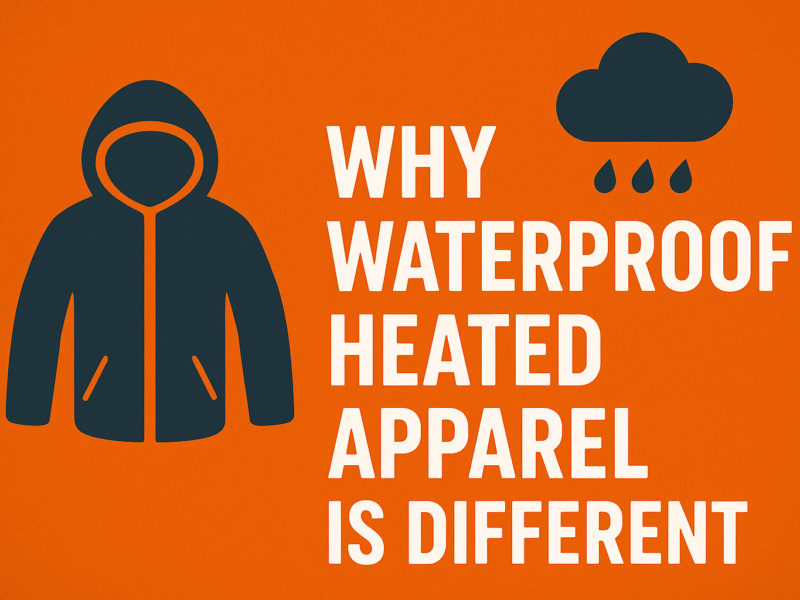
Introduction
Most heated jackets and vests on the market are built for chilly commutes—not for pouring rain, wet snow, or all-day outdoor work.
However, for workers, athletes, and adventurers in harsh environments, waterproof heated gear isn’t a luxury—it’s a necessity.
If your brand plans to target snowmobilers, construction crews, or utility workers, your product must combine thermal performance with proven waterproofing.
In this guide, we share the key principles behind designing, sourcing, and manufacturing waterproof heated apparel that performs in the real world.
🌧️ Why Waterproof Heated Apparel Is Different
Standard heated gear is often:
- Water-resistant at best
- Lined with open-weave polyester
- Not seam-sealed
- Vulnerable at power input ports and zipper lines
Therefore, for truly waterproof designs, you’ll need:
- Laminated outer fabrics (≥ 10,000 mm waterproof rating)
- Welded or sealed seams
- TPU-insulated heating systems
- Waterproof battery compartments
✅ At YubinGlobal, we’ve developed full-rainproof jackets for utility crews in Alaska and European rail service teams, with field-tested results.
🧵 1. Choosing Waterproof Fabrics for Heated Garments
Recommended Outer Materials
- 3L Softshell with PU Membrane: Ideal for warmth + breathability
- Nylon Ripstop with DWR coating: Lightweight + strong
- TPU-laminated polyester: For heavy-duty industrial applications
Key Fabric Ratings
When evaluating fabrics, look for:
- Waterproof rating ≥ 5,000 mm (light rain)
- ≥ 10,000 mm (heavy rain or snow)
- Windproof layers for full insulation
In addition, sourcing the right fabric can determine whether your product survives extreme conditions or fails in the field.
✅ We offer ready-made shells and OEM fabric sourcing with lab test reports.
🔋 2. Battery & Port Waterproofing: The Most Overlooked Risk
A common failure point in outdoor heated gear is battery exposure.
Protection Features to Include
- Covered USB ports with gasket seals
- Waterproof zipper garage on battery pocket
- Inner water shield pouch (PU-coated mesh or TPU film)
- IPX-rated cables and connectors
Battery Safety Standards
We recommend:
- UL/CE-certified batteries
- Encased controller switches
- Clearly labeled safety manuals
As a result, users get both safety and durability in wet-weather conditions.
✅ Our “outdoor series” batteries come with IP54 water-resistance, UN38.3 certified.
🧪 3. Heating Element Selection for Wet Environments
For true waterproof use, encapsulated heating systems are essential.
Options That Work
- TPU-laminated heating sheets (sealed wiring)
- Waterproof carbon fiber pads stitched into inner shell
- Bonded heating membranes (graphene or inkjet film)
Options to Avoid
- Exposed pads without heat sealing
- Hook-and-loop (Velcro) wiring that may detach under wet conditions
In fact, using the wrong heating element can compromise the entire garment.
✅ We’ve supplied TPU + softshell integrated jackets for Nordic maritime contractors.
🛠️ 4. Construction Details That Matter
Even with the right materials, gear can still leak or short-circuit due to poor construction.
Essential Construction Practices
- Seam taping (essential for jackets and pants)
- YKK AquaGuard zippers or equivalent
- Welded edges around heating panel zones
- Double-stitching + bar tacks on high-stress points
OEM Checklist
- Include waterproof pressure test during sampling
- Require IPX testing on the final product
- Validate wash cycles with water exposure simulation
Therefore, testing at every stage is non-negotiable for real-world reliability.
🎯 Target Use Scenarios That Demand Waterproof Heating
Waterproof heated gear can elevate your brand in several verticals.
For example, here are key applications:
| Use Case | Requirements |
|---|---|
| Utility & Energy Crew | ANSI reflective, waterproof, impact-rated |
| Snowmobile Riders | 10–12 hr battery, waterproof & windproof |
| Fishers/Hunters | Silent materials, battery warmth in wet |
| Emergency Services | UL-compliant, waterproof, quick-dry |
| Delivery Drivers | Urban-ready, lightweight waterproof |
💡 Don’t forget the rising petroleum, telecom, and railway sectors looking for rugged gear for 2025 and beyond.
📦 Packaging & Instruction for Safety
For wet-weather heated gear, always include:
- Printed user manual with rain-use warnings
- Spare zipper cover or battery sleeve
- Care instructions for drying + safe charging
- Battery storage SOP for field teams
Additionally, strong packaging builds customer trust and reduces liability.
✅ YubinGlobal offers co-branded instruction inserts + durable zipper pouches for bulk orders.
🧩 Case Study: Scandinavian Infrastructure Supplier
In 2024, a Swedish rail infrastructure contractor approached us for a CE-compliant heated softshell jacket suitable for snow and rain.
Requirements
- IPX4 heating system
- 8-hour runtime
- High-vis orange + reflective tape
- UL-certified battery + CE LVD documentation
Our Delivery
YubinGlobal provided:
- 1,200 pcs over 2 phases
- Customized TPU heating modules
- Field-tested jackets rated at −15°C, light snow, and 5 hrs of rain
As a result, the client was able to outfit crews with reliable, all-weather heated gear.
✅ Final Thoughts
Designing waterproof heated gear is a high-stakes challenge—but also a high-margin opportunity.
Overall, whether you’re serving tactical teams or alpine sport brands, rugged heated apparel needs more than warmth—it needs all-weather reliability.
At YubinGlobal, we help brands deliver advanced heated gear solutions with real-world waterproof performance.
📩 Ready to build your next waterproof heated line?
Contact us at info@yubinglobal.com

Recent Comments